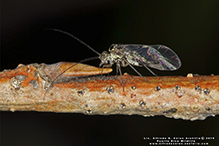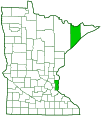common barklouse
(Hyalopsocus striatus)
Conservation • Description • Habitat • Ecology • Distribution • Taxonomy
|
|
||||||||||||||
Description |
There are just two North American species of Hyalopsocus. Only one, Hyalopsocus striatus, has been recorded in Minnesota. Hyalopsocus striatus is a small insect but a medium to large common barklouse. It occurs mostly in the northeastern United States and southeastern Canada. There are spotty records in the western United States, and only a few records in Minnesota. It is probably underreported, being overlooked due to its small size, and being difficult to distinguish from many similar species for the same reason. It is found on the trunks and branches of both hardwood trees and pine trees, on the shady sides of wood buildings, and on shaded wood piles. Adults are ⅛″ to 5⁄16″ (3.5 to 8.0 mm). The body is soft and bulbous. The head is relative large for the body. The forehead is swollen. The mouth parts are optimized for chewing. There are nine rod-shaped sensory receptors near the end of the upper lip (labrum). There are four membranous wings, two large forewings and two small hindwings. Both males and females have long, well developed forewings. On the forewing the basal one-third or two-thirds of the pterostigma is clear, the narrow posterior margin is clear, and the remainder is brown. There is a well-defined or diffuse spot bordering the branching of the first cubitus vein (M-Cu1), mostly after the branching point. The basal half of cell 1a is brown. Cell Cu2 is brown before the nodulus. There is a diffuse brown spot around the junction of the radial sector and the media veins (Rs-M). |
Size |
Total length: ⅛″ to 5⁄16″ (3.5 to 8.0 mm) |
Similar Species |
Habitat |
Deciduous and mixed woodlands, wood buildings, and wood piles |
Ecology |
Season |
|
Behavior |
Adults are attracted to light at night. |
Life Cycle |
|
Nymph Food |
|
Adult Food |
Algae |
Distribution |
||
|
Sources |
|
| 7/10/2025 | ||
Occurrence |
||
|
||
Taxonomy |
|
Order |
Psocodea (barklice, booklice, and parasitic lice) |
Suborder |
Psocomorpha |
Infraorder |
Psocetae |
Family |
Psocidae (common barklice) |
Subfamily |
Psocinae |
Tribe |
Psocini |
Genus |
Hyalopsocus |
Subordinate Taxa |
|
|
|
Synonyms |
|
Psocus frontalis Psocus striatus |
|
Common Names |
|
No species in this genus has a common name, nor does the genus itself. The common name for the family Psocidae is common barklice, and it is applied here for convenience. |
|
Glossary
Labrum
The upper part of the mouth, sometimes considered the lower part of the face, corresponding to the upper lip, on an insect or crustacean.
Nodus
On dragonflies and damselflies: the small notch on the lead edge of each wing about halfway between the body and the tip.
Pterostigma
The dark, blood-filled second cell at the leading edge of each wing toward the tip on many insects. It is heaver than adjacent, similar sized areas and is thought to dampen wing vibrations and signal mates. (= stigma. More precise than stigma but less often used, even by entomologists.)
Visitor Photos |
||
Share your photo of this insect. |
||
This button not working for you? |
||
Alfredo Colon |
 |
MinnesotaSeasons.com Photos |
||
|
||
|
||

Slideshows |
|

Visitor Videos |
||
Share your video of this insect. |
||
This button not working for you? |
||
|
Other Videos |
||
|

Created: 11/14/2020 Last Updated: © MinnesotaSeasons.com. All rights reserved. |


